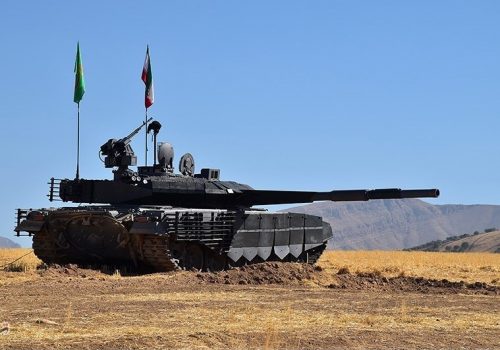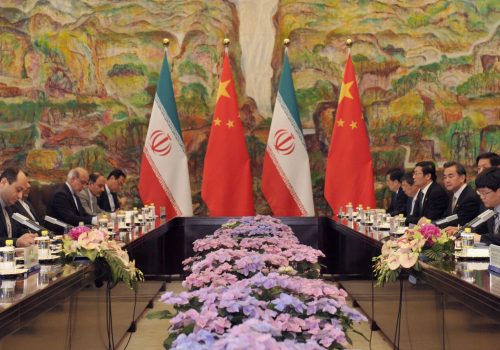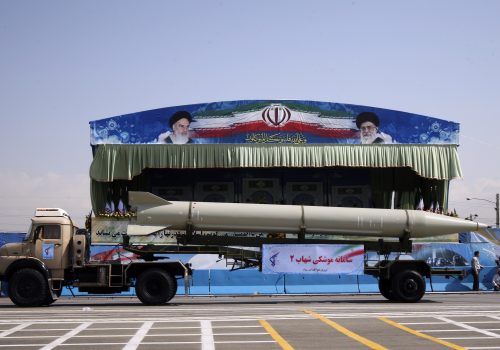Iran’s air attack tools have limited utility against adversaries
Iran’s military doctrine, including its deterrence philosophy, is heavily based on air attack tools, including ballistic and cruise missiles, as well as tactical artillery rockets and “kamikaze” drones that are armed with small explosive warheads.
They serve as partial compensation for Iran’s conventional weakness in advanced systems, such as combat aircraft, which would have difficulty operating in air space dominated and protected by Tehran’s adversaries in any case. Iran would be foolish to send its outdated fighter jets into enemy airspace in the event of war because they could easily be intercepted. Thus, Iran’s main option at present would be to use air attack means.
Iran’s other strategy—and a major advantage over its adversaries—is that these means can be used indirectly by a proxy group from the territory of another country, allowing Tehran to shield itself from responsibility. This is a fundamental element of Iran’s military philosophy, which allows it to carry out hostilities below the threshold of all-out war. By striking various targets, such as Saudi Arabia’s Aramco facilities in September 2019, Tehran can send a strong political message and embarrass its enemies, such as Riyadh, who has shown itself incapable of protecting key assets like international airports and energy infrastructure. This strategy even allows Iran to strike the United States, whose soldiers were targeted at Al Asad base in Iraq in January in retaliation for the US assassination of Quds Force commander Qasem Soleimani.
However, these tools would not be sufficient to give Iran a victory in an open military confrontation or even allow it to make significant strategic gains.
To illustrate this point, consider Iran’s long-range ballistic missiles, which have been used in Iraq, Syria, and Yemen. Regarding Syria, Iran conducted at least two major strikes against the Islamic State of Iraq and al-Sham (ISIS)—Operation “Laikat al-Qadr” in 2017 and Operation “Muharram” in 2018. In the latter year, Iran launched seven Fateh-313 short-range missiles against Kurdish targets in Iraq. Although these operations demonstrated Iran’s ability to strike and inflict some casualties, they did not change the strategic balance in favor of Tehran.
The most accurate assessment of the real potential of Iran’s strike capabilities can be found in the war in Yemen, in which various types of missiles have been abundantly used by Tehran’s allies—the Houthis. According to Saudi Arabia, 313 ballistic missiles and 357 drones have been intercepted since 2015. Some exploded in Saudi Arabia but only a few resulted in damage or casualties. At least two incidents—one in September 2015, resulting in the death of sixty soldiers and one in December 2015, which killed one hundred soldiers—were caused by ex-Yemeni OTR-21 Tochka tactical ballistic missiles, not Iranian missiles. Moreover, neither Iran nor its Yemeni allies have been able to significantly hurt Saudi energy infrastructure or disrupt its oil exports for a long period of time. Despite repeated Houthi attempts, Saudi civilian airports have not been paralyzed. The attack on Saudi Aramco in September 2019 was an exception, but Riyadh’s oil production recovered within a few weeks and their crude price decreased very quickly even in this case.
The same applies to Iranian drones, which have also been liberally used in Yemen. Admittedly, some accomplishments have been reported. One such attack occurred in January 2019, when a drone killed six Yemeni soldiers during a military parade. However, these were tactical victories that didn’t necessarily turn into strategic gains. The Houthis’ current strong position in Yemen—after more than five years of warfare—is mainly a result of Saudi military weakness and Houthi strength, rather than strikes via Iran-supplied missiles and rockets.
The same applies to cruise missiles, which can strike both naval and land-based targets. Nowadays, cruise missiles are an important tool for many countries, including Iran, who has developed various systems—many of them based on Chinese technology. One of these missiles, which was fired by the Lebanese militant group Hezbollah in 2006, severely damaged the Israeli corvette INS “Hanit.” Ten years later, the Houthis almost sank an Emirati HSV-2 transport catamaran off the Yemeni coast.
However, in recent years, technology has significantly evolved and now all modern warships are equipped with self-protection systems, enabling them to detect and engage such threats and reduce the risk of being hit. For instance, in 2016, two US guided destroyers, the USS Mason and the USS Nitze, protected themselves from several enemy anti-ship missiles fired from Yemen. Moreover, Iran’s coastal anti-ship batteries are not well protected from air threats and, thus, at least some of them could be destroyed by enemy long-range air-to-ground missiles that are fired from safe distances. Since Iran’s units are mobile and use camouflage, it is unlikely that all of them would be destroyed from the air, but Iranian capabilities would be degraded nevertheless.
However, if the UN arms embargo is lifted in October, Iran will have a chance to procure some niche and highly sophisticated technologies that can be considered to be “force multipliers” (i.e. when additional features increase general performance of a particular system). That includes improved homing systems for missiles (active radar or infrared), better engines, new generation electronic sub-components or modern multi-mode seekers, and an ability to defeat targets’ countermeasures. That also potentially includes technologies allowing Iran to convert its non-guided artillery rockets into guided missiles. Although the Iranian defense industry has already been working on such issues, foreign technologies would enable a quantum leap forward. Nonetheless, due to several factors, including inevitable US pressure and a relatively small group of countries possessing those technologies, it will be a challenge for Iran to find suppliers—with the exception of China and Russia.
To summarize, while it would be a mistake to downplay the lethal potential of Iran’s air attack means, the assumption that they are omnipotent and can always shift the strategic balance is false. These instruments are neither a magic wand nor an ultimate weapon. They can impact a tactical level of a low-intensity conflict, harass Iran’s enemies, and increase the political, economic and military costs of waging a war. Despite this, they are not necessarily sufficient to win a full-scale war or even significantly change the strategic balance in favor of Tehran.
Robert Czulda is an assistant professor at the University of Lodz, Poland and a former visiting professor at Islamic Azad University in Iran, the University of Maryland and National Cheng-chi University in Taiwan. He is the author of Iran 1925 – 2014: From Reza Shah to Rouhani. Follow him on Twitter: @RobertCzulda.
Image: A military truck carrying a Raad missile drives past a picture of Iran's Supreme Leader Ayatollah Ali Khamenei (R) during a parade marking the anniversary of the Iran-Iraq war (1980-88), in Tehran September 22, 2015. REUTERS/Raheb Homavandi/TIMA


